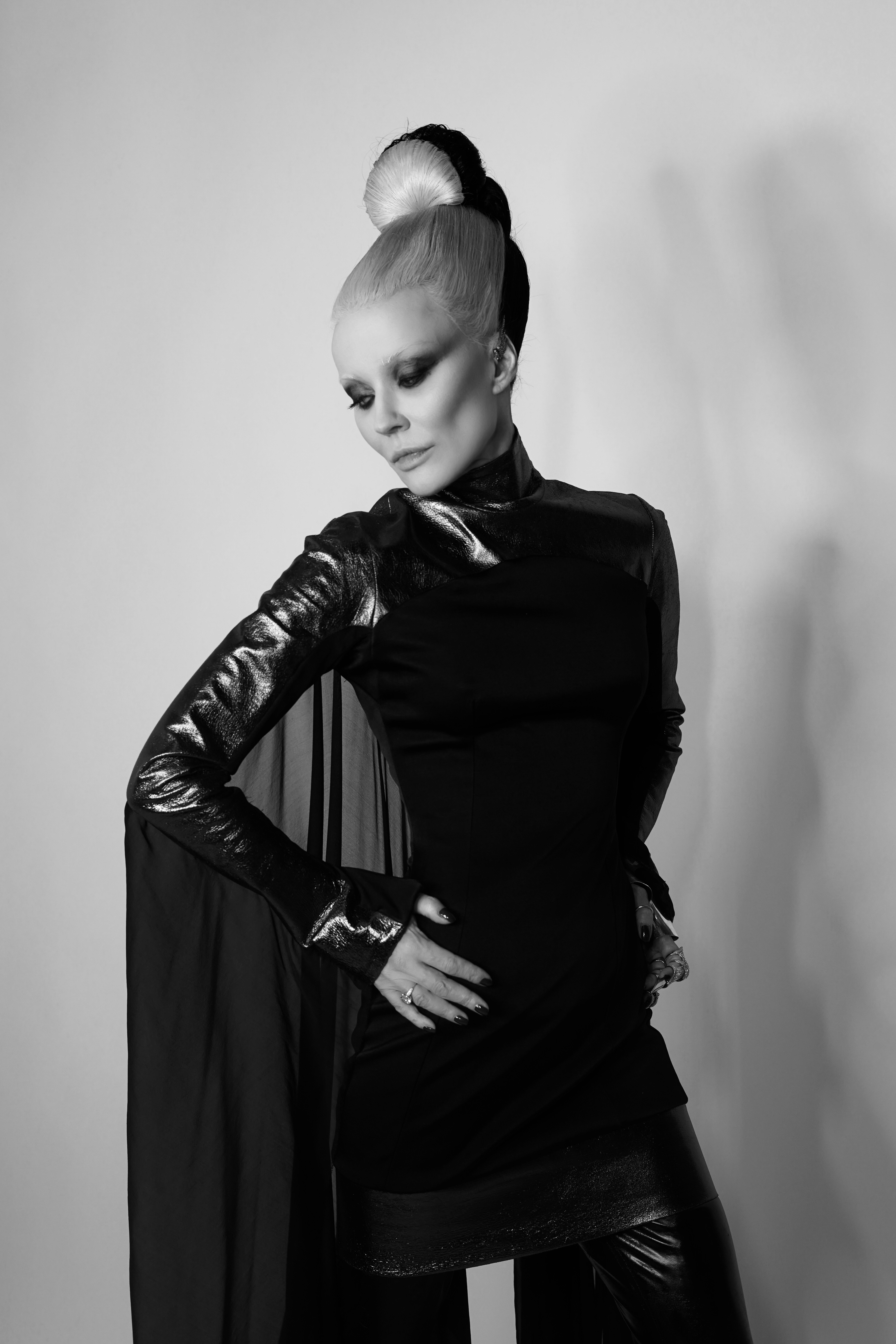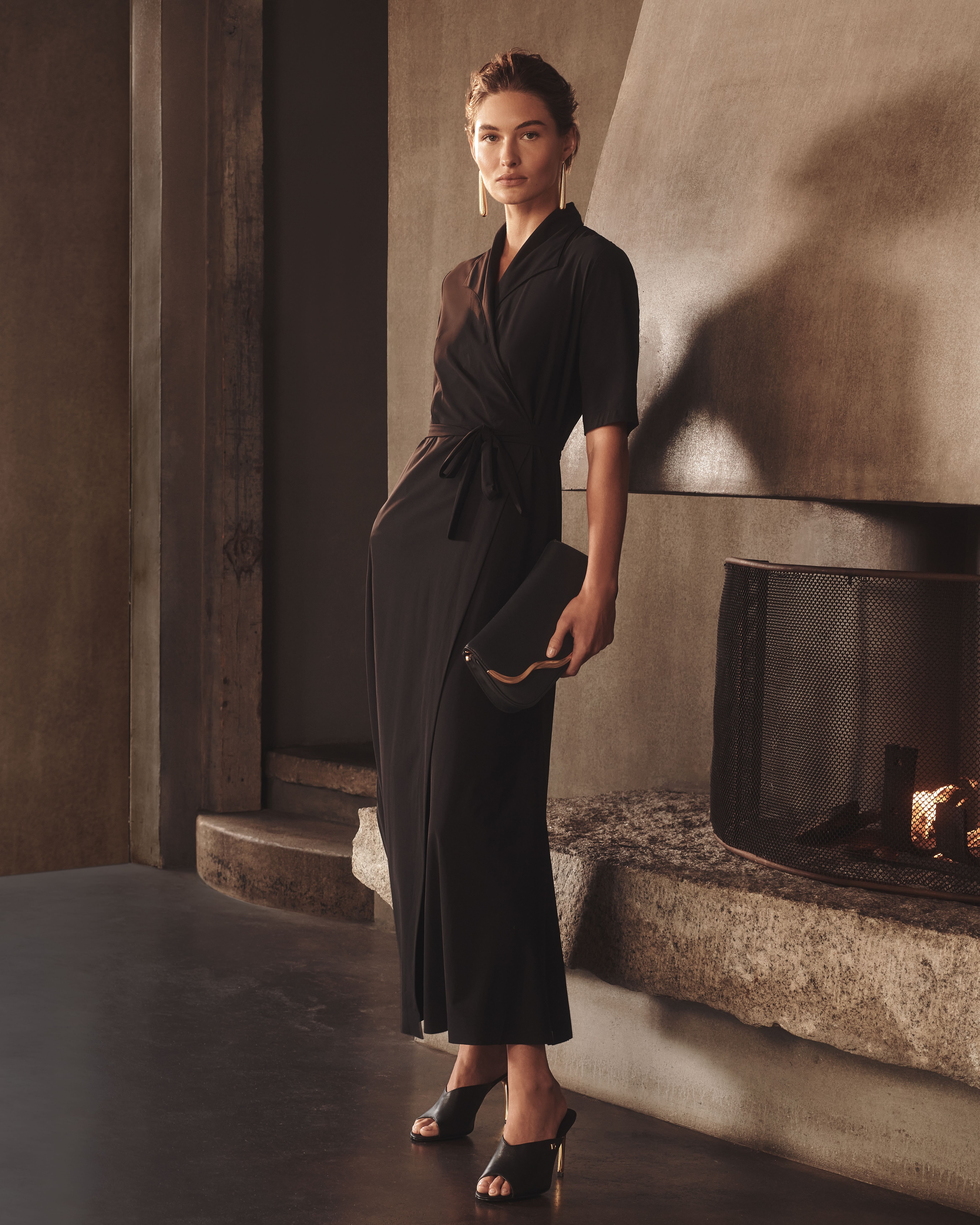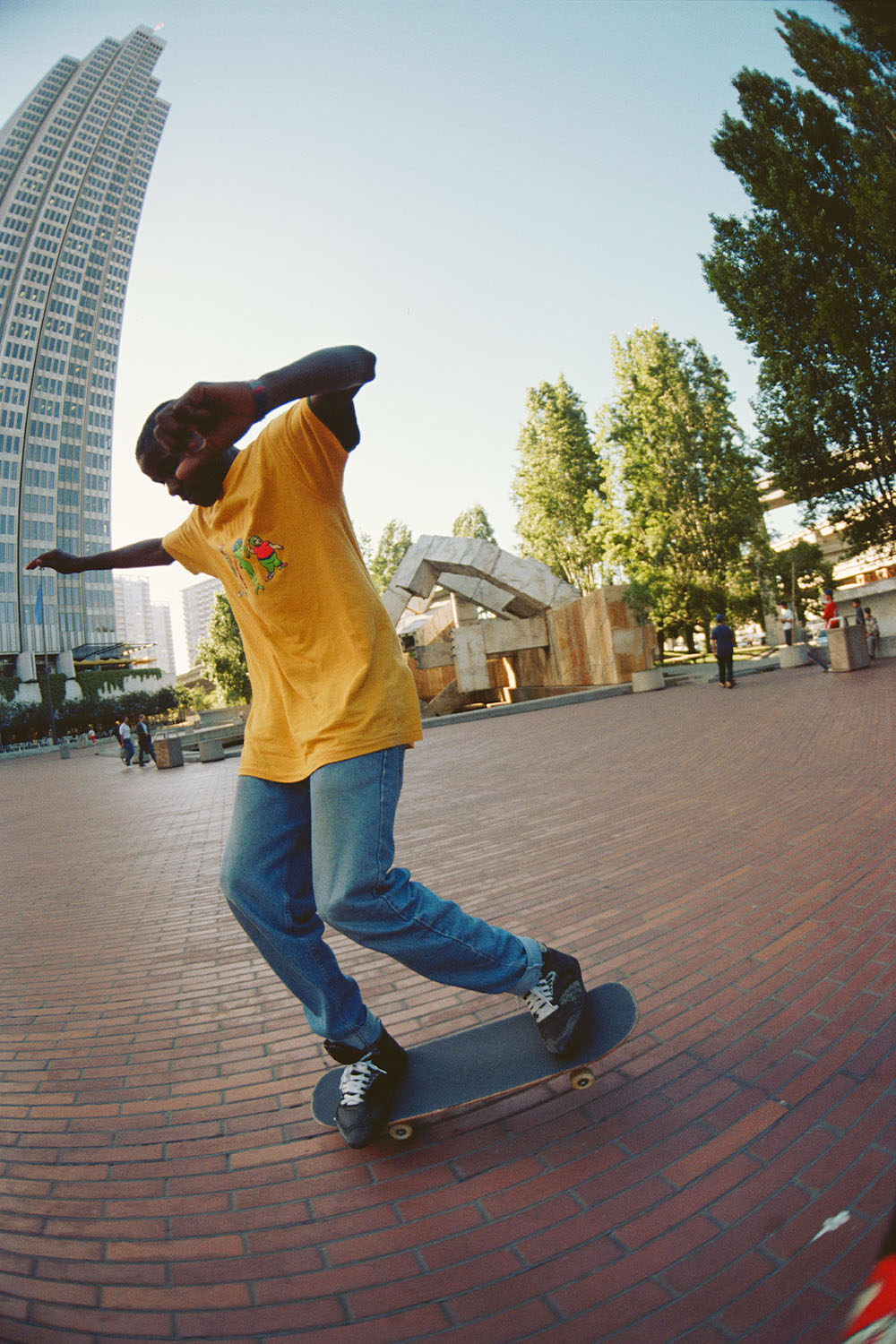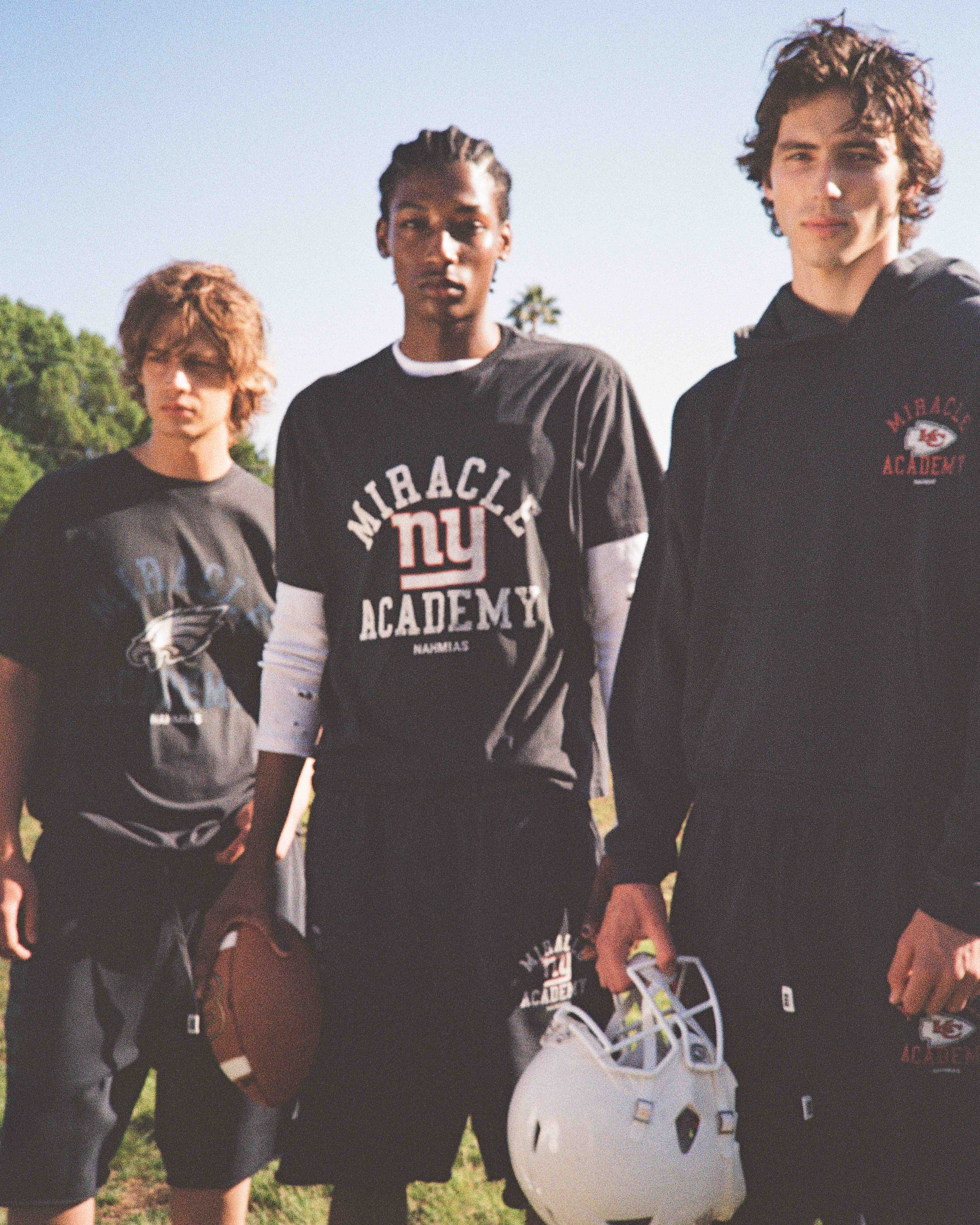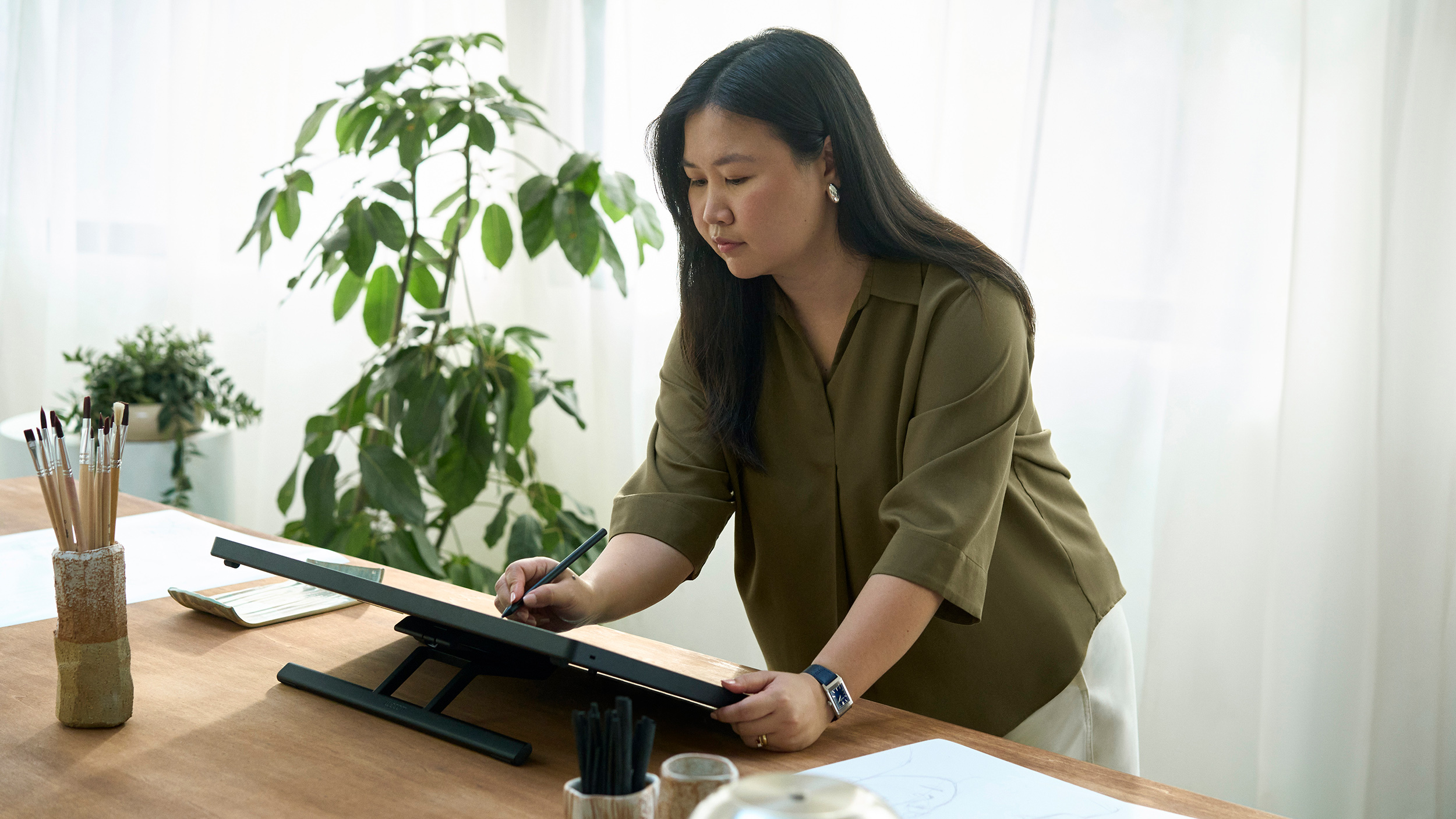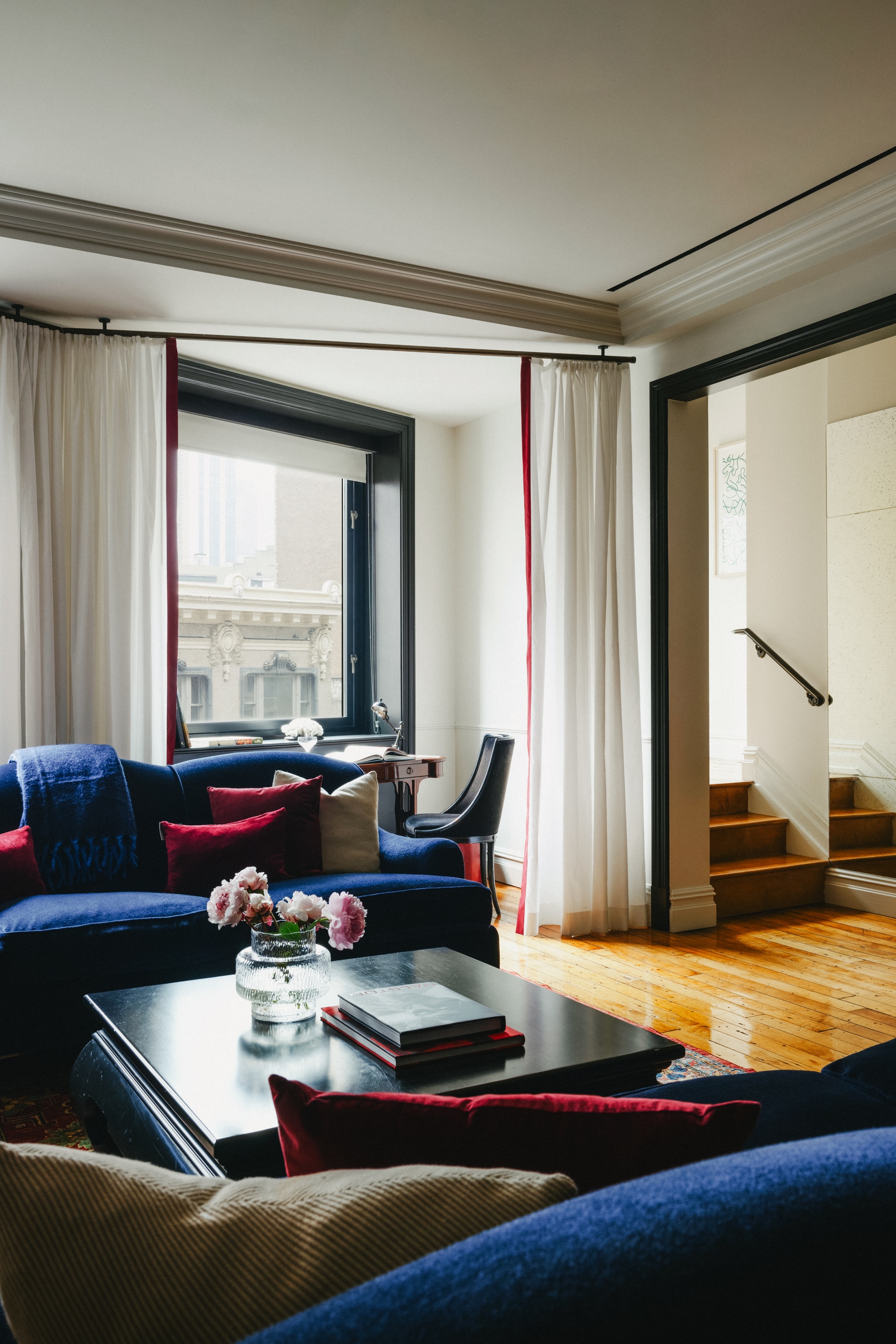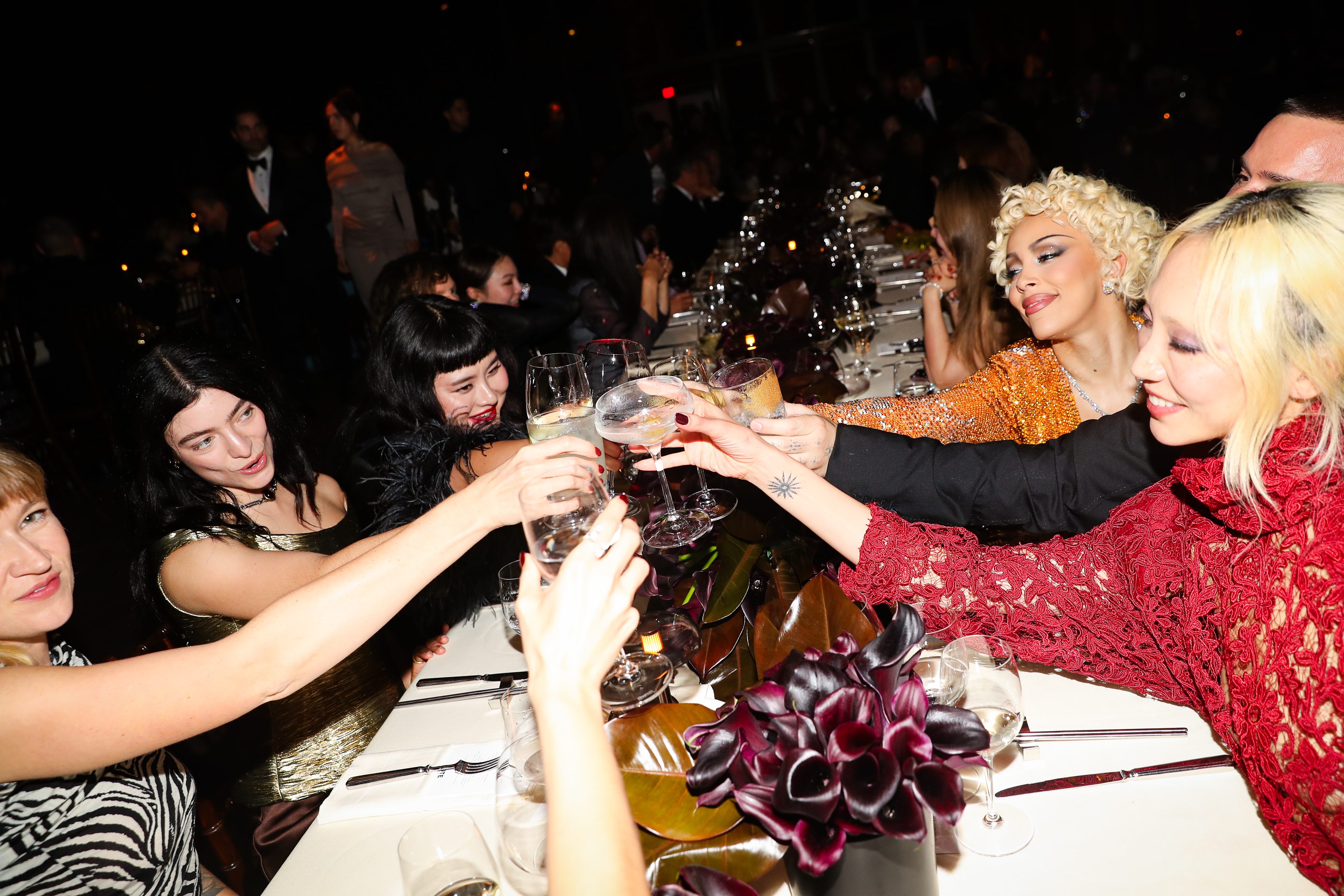

Courtesy Jack Levinson
The writer/director/painter Jack Levinson has placed together a performance for “Ladies of the Canyon” the first installment in an ongoing scripted series called [_The Square Circle Story_](https://www.thesquarecirclestory.com/). This experiential adaptation of his abstract 4th dimensional performance was initially conceived in 2015 when he organized dinner events which brought guests into the scripts by prompting them to take on personas at the beginning of the night.
The central focus is a celebration and continual narration of a band depicted in the golden age of indie and Freak Folk of the mid aughts, which saw the rise of a generation alternative and genre bending folk musicians. The experimental theater debut will be performed at the recently opened Murmurs space in Downtown LA. We took a moment to catch up with the creative to speak about the last days of indie rock, the binary norms of the eras Freak Folk scene, and the adaptation from dinning room to the stage
**Tell us more about _The Square Circle Story_ and all that indie era madness.**
So, this project is called _The Square Circle Story_ and it is a series of screenplays that I have been writing since 2012 that are all centered around a fictional Indie Rock band. In the series, which is set from 2003 to 2012, they become the biggest Indie Rock band of their time, sort of bigger than any indie rock band actually became. And each screenplay finds the band in a different moments in their career, and it jumps through time. This installment of it starts in 2006 with the band moving to LA. They’ve just been signed to a major label. They haven’t released their record yet, but they’re about to become total icons. And they have followed this folk singer there who’s dating one of the band members.
They arrive in LA and they sort of enter her social world. So I’ve been writing these scripts and then rather than trying to get them produced as films, I’ve been seeing these different performance contexts for them. Previously with this script, I’ve hosted dinner parties where guests come and pull a name from a hat and that’s their character in the script. We do a cold read all together. I wanted for a long time to actually work with a cast and bring people together and do a more theatrical thing, but we’re waiting for an opportunity to arise and to write more installments of the series. I finished this script in 2015, and earlier this year Mercedes Kilmer was at a reading and she approached me with Allison Littrell about hosting this as a theatrical production at Allison's new venue, Murmurs, which she runs with Morgan Elder. So suddenly there's this new context: it's going to have a cast of 14 people, I’m drawing all the backdrops which are going to be projected behind the actors, and I’m going to be narrating the production. It’s technically a play, but it somehow feels different from that – because it is written as a screenplay the whole thing is intended to feel like a movie, and almost be like a stand-in for a movie, but then also this very festive and social event where there’s gonna be a bar and music and hopefully people hang around and just meeting each other. So, it’s hopefully gonna be a happening.
**So it’s like more of an immersive version of a play that is seen through a screenplay’s narrative?**
Yeah, totally. And parts of the screenplay, the way it’s written as a text there are certain things that are not filmable. A character might get a monologue and then in the action description there will be like “Well none of that is true. What actually happened is ‘this, this and this’” In a movie, there would be no way to really show that, but in the script that’s my function. I’m on stage narrating it, giving additional information. So, it’s somewhere between a screenplay and a novel actually. But, it turns into a play somehow.


Courtesy Jack Levinson
**Who is part of the cast? Will Mercedes and Allison going to be performing?**
Mercedes is in the cast; she plays a the folk singer Libby Ames, who brings the band out to LA. Libby Ames is also a really prominent character in the series. She’s a folk singer. She grew up in LA. She has this very tight knit group of friends. She becomes the fictional face of the freak folk scene. I looked at a lot of real life case studies and sort of synthesized them all together. So, I would say Libby falls somewhere on the spectrum between Joanne Newsom and Jenny Lewis.
**Omg this is pulling me into so many feelings of that era. How did they rest of the cast take to this music era?**
Mercedes has been amazing to work with on that because she understands that whole genre so well. And it’s very satirical and she has a really great sense of humor about it. Basically, Libby is actually in the script as a more prominent character than the band is. The band is sort of in the background. Libby has a concert in this. It’s all leading up to her concert, this whole crazy series of events.
**Could you explain more about the freak folk thing? I know what it is, but I think it’s been a while since the public has revisited that era and the songs and style.**
Yeah, it’s been about 15 years. Basically, to make it a larger conversation about the whole series, something I’ve been really interested in is all of this stuff as the backdrop to me being an adolescent. Everything that I thought was cool when I was 15 years old. Things like freak folk and even indie rock in general are- at the time they felt like the cutting edge, and now they’re sort of forgotten. They’re so irrelevant, and what is now considered cool is so wildly different from that. Something that I found to be specifically really interesting about freak folk, and indie rock, but especially freak folk is that in the aughts- like now what’s fashionable is all of this anachronistic- you’re wearing cowboy boots but you’re also wearing something like glam rock and then maybe you have some sort of skater hat- like everything’s like a… very maximalist, and very hybrid. Whereas in 2006, they were all just sort of doing cosplay. Where a freak folk singer was just in full blown Western gear, head to toe, and that was what was chic.
**How do you explain CocoRosie?**
Interesting... I guess CocoRosie was on the fringe of- or like the vanguard. But, Joanna Newsom, I’ll say was a great example of it. She was just dressed like a pioneer, you know? Or Devendra Banhart, in his way, it was a very consistent whole thing. You know what I mean? Now, I can’t think of anybody who’s just one...


Courtesy Jack Levinson
**It was before the queering of pop culture, so it was a very in that space of binary aesthetics.** **I mean that’s what I loved about Coco Rose. It was so queer. They were modely looking people with mustaches and shit.**
Yes, totally. I’ve actually been really interested in the idea of indie-rock bands as the last moment when a group of four white guys would be considered subversive. It’s funny now when you look back and see who was big then and considered the coolest of the cool. But thinking about it, I think you're so right – that hybrid-cultures thing was totally picking up steam right around then and was actually a big part of 2006 culture, maybe in opposition to the Jack White ethos. I guess the difference was really that at the time, there was a novelty factor, so a lot of music/fashion/culture that involved genre-bending made a point of specifically flagging itself as that (and maybe wasn't about anything else), as opposed to now, when breaking and blending genre conventions is the standard in the mainstream. And it is totally related to the breakdown of the gender binary and the internet content-dump vibes that were starting to escalate right around then. In fact this topic actually comes up in the script, with one character tripping out as she listens to Girl Talk and the folk singer character defending her love of the mash-up in an interview.
**It’s funny that you’re explaining that as something that is glued to LA but in reality all the bands that we idolize were either New York City or LA rooted.**
Totally. In "Ladies of the Canyon" Square Circle have just arrived from Williamsburg. They came, they saw, they conquered. And now it’s time for them to go to LA. They signed to their major label and they hit the town.
**How do you feel about taking this project out of the dining room and onto the stage?**
I think what’s really exciting to me about this production is the idea that the way I’ve previously shared this project as this interactive event. One of what we did is create this sense of community around it, and made this whole story this cult project where Square Circle is this fake band that has these fans now that are real people that have been to these shows. So now working with a cast, and expanding that, and trying to maintain the spirit of people feeling like they’re a part of it and feeling like they know this secret. That is the guiding impulse in doing the play in this way.
**Yeah, to see it the band actually live as a band almost.**
Yeah, totally. It’s been so cool seeing some people who look exactly like what I imagined the characters to look and some have given it a totally different spin/twist and I love that. I’ve been very encouraging of every actor to really riff on it in their own way. With the feeling of I’ve spent so long controlling myself and being so nervous about sharing it. So now, to be working with other people, it feels like this big “Okay, everybody’s been putting their talent and ideas to it, and everybody should just run with it.”
**Was there music that’s involved that was written?**
It includes some lyrics to the songs. I don’t know how to actually write music, but I have written some lyrics to some of Libby’s songs which are included in the performance. And the whole thing will be heavily soundtracked by hits from the time.
**Anything else you’d like to mention?**
I guess I should say that part of what’s exciting about the timing of this is that I now have two other installments of it finished. And I think when this is over, I'm going to put those up in the interactive style. So that the story can keep expanding, and more and more people can get involved in it. This project is a very unconventional format, and people have disputed how viable it would be. Or if it's a good idea to write something that is written in this really idiosyncratic way. What I have found in this process is that the strangeness of the format is what has been making it exciting to people and what's been making it an event that people want to get involved with. So I that's just been a really empowering and exciting thing to have happen. It generates so much, and people bring so many original ideas to it. So, I'm insanely excited for it.
**Awesome. Thank you.**
* * *
Ladies of the Canyon
Produced by Mercedes Kilmer, Jack Levinson, and Murmurs LA
Written, Directed, and Illustrated by Jack Levinson.
Friday, August 9th & Saturday, August 10th 2019 | 7:30pm
Tickets can be purchased [here](https://murmurs.la/Ladies-of-the-Canyon)
 
Courtesy Jack Levinson
The writer/director/painter Jack Levinson has placed together a performance for “Ladies of the Canyon” the first installment in an ongoing scripted series called [_The Square Circle Story_](https://www.thesquarecirclestory.com/). This experiential adaptation of his abstract 4th dimensional performance was initially conceived in 2015 when he organized dinner events which brought guests into the scripts by prompting them to take on personas at the beginning of the night.
The central focus is a celebration and continual narration of a band depicted in the golden age of indie and Freak Folk of the mid aughts, which saw the rise of a generation alternative and genre bending folk musicians. The experimental theater debut will be performed at the recently opened Murmurs space in Downtown LA. We took a moment to catch up with the creative to speak about the last days of indie rock, the binary norms of the eras Freak Folk scene, and the adaptation from dinning room to the stage
**Tell us more about _The Square Circle Story_ and all that indie era madness.**
So, this project is called _The Square Circle Story_ and it is a series of screenplays that I have been writing since 2012 that are all centered around a fictional Indie Rock band. In the series, which is set from 2003 to 2012, they become the biggest Indie Rock band of their time, sort of bigger than any indie rock band actually became. And each screenplay finds the band in a different moments in their career, and it jumps through time. This installment of it starts in 2006 with the band moving to LA. They’ve just been signed to a major label. They haven’t released their record yet, but they’re about to become total icons. And they have followed this folk singer there who’s dating one of the band members.
They arrive in LA and they sort of enter her social world. So I’ve been writing these scripts and then rather than trying to get them produced as films, I’ve been seeing these different performance contexts for them. Previously with this script, I’ve hosted dinner parties where guests come and pull a name from a hat and that’s their character in the script. We do a cold read all together. I wanted for a long time to actually work with a cast and bring people together and do a more theatrical thing, but we’re waiting for an opportunity to arise and to write more installments of the series. I finished this script in 2015, and earlier this year Mercedes Kilmer was at a reading and she approached me with Allison Littrell about hosting this as a theatrical production at Allison's new venue, Murmurs, which she runs with Morgan Elder. So suddenly there's this new context: it's going to have a cast of 14 people, I’m drawing all the backdrops which are going to be projected behind the actors, and I’m going to be narrating the production. It’s technically a play, but it somehow feels different from that – because it is written as a screenplay the whole thing is intended to feel like a movie, and almost be like a stand-in for a movie, but then also this very festive and social event where there’s gonna be a bar and music and hopefully people hang around and just meeting each other. So, it’s hopefully gonna be a happening.
**So it’s like more of an immersive version of a play that is seen through a screenplay’s narrative?**
Yeah, totally. And parts of the screenplay, the way it’s written as a text there are certain things that are not filmable. A character might get a monologue and then in the action description there will be like “Well none of that is true. What actually happened is ‘this, this and this’” In a movie, there would be no way to really show that, but in the script that’s my function. I’m on stage narrating it, giving additional information. So, it’s somewhere between a screenplay and a novel actually. But, it turns into a play somehow.

Courtesy Jack Levinson
The writer/director/painter Jack Levinson has placed together a performance for “Ladies of the Canyon” the first installment in an ongoing scripted series called [_The Square Circle Story_](https://www.thesquarecirclestory.com/). This experiential adaptation of his abstract 4th dimensional performance was initially conceived in 2015 when he organized dinner events which brought guests into the scripts by prompting them to take on personas at the beginning of the night.
The central focus is a celebration and continual narration of a band depicted in the golden age of indie and Freak Folk of the mid aughts, which saw the rise of a generation alternative and genre bending folk musicians. The experimental theater debut will be performed at the recently opened Murmurs space in Downtown LA. We took a moment to catch up with the creative to speak about the last days of indie rock, the binary norms of the eras Freak Folk scene, and the adaptation from dinning room to the stage
**Tell us more about _The Square Circle Story_ and all that indie era madness.**
So, this project is called _The Square Circle Story_ and it is a series of screenplays that I have been writing since 2012 that are all centered around a fictional Indie Rock band. In the series, which is set from 2003 to 2012, they become the biggest Indie Rock band of their time, sort of bigger than any indie rock band actually became. And each screenplay finds the band in a different moments in their career, and it jumps through time. This installment of it starts in 2006 with the band moving to LA. They’ve just been signed to a major label. They haven’t released their record yet, but they’re about to become total icons. And they have followed this folk singer there who’s dating one of the band members.
They arrive in LA and they sort of enter her social world. So I’ve been writing these scripts and then rather than trying to get them produced as films, I’ve been seeing these different performance contexts for them. Previously with this script, I’ve hosted dinner parties where guests come and pull a name from a hat and that’s their character in the script. We do a cold read all together. I wanted for a long time to actually work with a cast and bring people together and do a more theatrical thing, but we’re waiting for an opportunity to arise and to write more installments of the series. I finished this script in 2015, and earlier this year Mercedes Kilmer was at a reading and she approached me with Allison Littrell about hosting this as a theatrical production at Allison's new venue, Murmurs, which she runs with Morgan Elder. So suddenly there's this new context: it's going to have a cast of 14 people, I’m drawing all the backdrops which are going to be projected behind the actors, and I’m going to be narrating the production. It’s technically a play, but it somehow feels different from that – because it is written as a screenplay the whole thing is intended to feel like a movie, and almost be like a stand-in for a movie, but then also this very festive and social event where there’s gonna be a bar and music and hopefully people hang around and just meeting each other. So, it’s hopefully gonna be a happening.
**So it’s like more of an immersive version of a play that is seen through a screenplay’s narrative?**
Yeah, totally. And parts of the screenplay, the way it’s written as a text there are certain things that are not filmable. A character might get a monologue and then in the action description there will be like “Well none of that is true. What actually happened is ‘this, this and this’” In a movie, there would be no way to really show that, but in the script that’s my function. I’m on stage narrating it, giving additional information. So, it’s somewhere between a screenplay and a novel actually. But, it turns into a play somehow.
 
Courtesy Jack Levinson
**Who is part of the cast? Will Mercedes and Allison going to be performing?**
Mercedes is in the cast; she plays a the folk singer Libby Ames, who brings the band out to LA. Libby Ames is also a really prominent character in the series. She’s a folk singer. She grew up in LA. She has this very tight knit group of friends. She becomes the fictional face of the freak folk scene. I looked at a lot of real life case studies and sort of synthesized them all together. So, I would say Libby falls somewhere on the spectrum between Joanne Newsom and Jenny Lewis.
**Omg this is pulling me into so many feelings of that era. How did they rest of the cast take to this music era?**
Mercedes has been amazing to work with on that because she understands that whole genre so well. And it’s very satirical and she has a really great sense of humor about it. Basically, Libby is actually in the script as a more prominent character than the band is. The band is sort of in the background. Libby has a concert in this. It’s all leading up to her concert, this whole crazy series of events.
**Could you explain more about the freak folk thing? I know what it is, but I think it’s been a while since the public has revisited that era and the songs and style.**
Yeah, it’s been about 15 years. Basically, to make it a larger conversation about the whole series, something I’ve been really interested in is all of this stuff as the backdrop to me being an adolescent. Everything that I thought was cool when I was 15 years old. Things like freak folk and even indie rock in general are- at the time they felt like the cutting edge, and now they’re sort of forgotten. They’re so irrelevant, and what is now considered cool is so wildly different from that. Something that I found to be specifically really interesting about freak folk, and indie rock, but especially freak folk is that in the aughts- like now what’s fashionable is all of this anachronistic- you’re wearing cowboy boots but you’re also wearing something like glam rock and then maybe you have some sort of skater hat- like everything’s like a… very maximalist, and very hybrid. Whereas in 2006, they were all just sort of doing cosplay. Where a freak folk singer was just in full blown Western gear, head to toe, and that was what was chic.
**How do you explain CocoRosie?**
Interesting... I guess CocoRosie was on the fringe of- or like the vanguard. But, Joanna Newsom, I’ll say was a great example of it. She was just dressed like a pioneer, you know? Or Devendra Banhart, in his way, it was a very consistent whole thing. You know what I mean? Now, I can’t think of anybody who’s just one...

Courtesy Jack Levinson
**Who is part of the cast? Will Mercedes and Allison going to be performing?**
Mercedes is in the cast; she plays a the folk singer Libby Ames, who brings the band out to LA. Libby Ames is also a really prominent character in the series. She’s a folk singer. She grew up in LA. She has this very tight knit group of friends. She becomes the fictional face of the freak folk scene. I looked at a lot of real life case studies and sort of synthesized them all together. So, I would say Libby falls somewhere on the spectrum between Joanne Newsom and Jenny Lewis.
**Omg this is pulling me into so many feelings of that era. How did they rest of the cast take to this music era?**
Mercedes has been amazing to work with on that because she understands that whole genre so well. And it’s very satirical and she has a really great sense of humor about it. Basically, Libby is actually in the script as a more prominent character than the band is. The band is sort of in the background. Libby has a concert in this. It’s all leading up to her concert, this whole crazy series of events.
**Could you explain more about the freak folk thing? I know what it is, but I think it’s been a while since the public has revisited that era and the songs and style.**
Yeah, it’s been about 15 years. Basically, to make it a larger conversation about the whole series, something I’ve been really interested in is all of this stuff as the backdrop to me being an adolescent. Everything that I thought was cool when I was 15 years old. Things like freak folk and even indie rock in general are- at the time they felt like the cutting edge, and now they’re sort of forgotten. They’re so irrelevant, and what is now considered cool is so wildly different from that. Something that I found to be specifically really interesting about freak folk, and indie rock, but especially freak folk is that in the aughts- like now what’s fashionable is all of this anachronistic- you’re wearing cowboy boots but you’re also wearing something like glam rock and then maybe you have some sort of skater hat- like everything’s like a… very maximalist, and very hybrid. Whereas in 2006, they were all just sort of doing cosplay. Where a freak folk singer was just in full blown Western gear, head to toe, and that was what was chic.
**How do you explain CocoRosie?**
Interesting... I guess CocoRosie was on the fringe of- or like the vanguard. But, Joanna Newsom, I’ll say was a great example of it. She was just dressed like a pioneer, you know? Or Devendra Banhart, in his way, it was a very consistent whole thing. You know what I mean? Now, I can’t think of anybody who’s just one...
 
Courtesy Jack Levinson
**It was before the queering of pop culture, so it was a very in that space of binary aesthetics.** **I mean that’s what I loved about Coco Rose. It was so queer. They were modely looking people with mustaches and shit.**
Yes, totally. I’ve actually been really interested in the idea of indie-rock bands as the last moment when a group of four white guys would be considered subversive. It’s funny now when you look back and see who was big then and considered the coolest of the cool. But thinking about it, I think you're so right – that hybrid-cultures thing was totally picking up steam right around then and was actually a big part of 2006 culture, maybe in opposition to the Jack White ethos. I guess the difference was really that at the time, there was a novelty factor, so a lot of music/fashion/culture that involved genre-bending made a point of specifically flagging itself as that (and maybe wasn't about anything else), as opposed to now, when breaking and blending genre conventions is the standard in the mainstream. And it is totally related to the breakdown of the gender binary and the internet content-dump vibes that were starting to escalate right around then. In fact this topic actually comes up in the script, with one character tripping out as she listens to Girl Talk and the folk singer character defending her love of the mash-up in an interview.
**It’s funny that you’re explaining that as something that is glued to LA but in reality all the bands that we idolize were either New York City or LA rooted.**
Totally. In "Ladies of the Canyon" Square Circle have just arrived from Williamsburg. They came, they saw, they conquered. And now it’s time for them to go to LA. They signed to their major label and they hit the town.
**How do you feel about taking this project out of the dining room and onto the stage?**
I think what’s really exciting to me about this production is the idea that the way I’ve previously shared this project as this interactive event. One of what we did is create this sense of community around it, and made this whole story this cult project where Square Circle is this fake band that has these fans now that are real people that have been to these shows. So now working with a cast, and expanding that, and trying to maintain the spirit of people feeling like they’re a part of it and feeling like they know this secret. That is the guiding impulse in doing the play in this way.
**Yeah, to see it the band actually live as a band almost.**
Yeah, totally. It’s been so cool seeing some people who look exactly like what I imagined the characters to look and some have given it a totally different spin/twist and I love that. I’ve been very encouraging of every actor to really riff on it in their own way. With the feeling of I’ve spent so long controlling myself and being so nervous about sharing it. So now, to be working with other people, it feels like this big “Okay, everybody’s been putting their talent and ideas to it, and everybody should just run with it.”
**Was there music that’s involved that was written?**
It includes some lyrics to the songs. I don’t know how to actually write music, but I have written some lyrics to some of Libby’s songs which are included in the performance. And the whole thing will be heavily soundtracked by hits from the time.
**Anything else you’d like to mention?**
I guess I should say that part of what’s exciting about the timing of this is that I now have two other installments of it finished. And I think when this is over, I'm going to put those up in the interactive style. So that the story can keep expanding, and more and more people can get involved in it. This project is a very unconventional format, and people have disputed how viable it would be. Or if it's a good idea to write something that is written in this really idiosyncratic way. What I have found in this process is that the strangeness of the format is what has been making it exciting to people and what's been making it an event that people want to get involved with. So I that's just been a really empowering and exciting thing to have happen. It generates so much, and people bring so many original ideas to it. So, I'm insanely excited for it.
**Awesome. Thank you.**
* * *
Ladies of the Canyon
Produced by Mercedes Kilmer, Jack Levinson, and Murmurs LA
Written, Directed, and Illustrated by Jack Levinson.
Friday, August 9th & Saturday, August 10th 2019 | 7:30pm
Tickets can be purchased [here](https://murmurs.la/Ladies-of-the-Canyon)

Courtesy Jack Levinson
**It was before the queering of pop culture, so it was a very in that space of binary aesthetics.** **I mean that’s what I loved about Coco Rose. It was so queer. They were modely looking people with mustaches and shit.**
Yes, totally. I’ve actually been really interested in the idea of indie-rock bands as the last moment when a group of four white guys would be considered subversive. It’s funny now when you look back and see who was big then and considered the coolest of the cool. But thinking about it, I think you're so right – that hybrid-cultures thing was totally picking up steam right around then and was actually a big part of 2006 culture, maybe in opposition to the Jack White ethos. I guess the difference was really that at the time, there was a novelty factor, so a lot of music/fashion/culture that involved genre-bending made a point of specifically flagging itself as that (and maybe wasn't about anything else), as opposed to now, when breaking and blending genre conventions is the standard in the mainstream. And it is totally related to the breakdown of the gender binary and the internet content-dump vibes that were starting to escalate right around then. In fact this topic actually comes up in the script, with one character tripping out as she listens to Girl Talk and the folk singer character defending her love of the mash-up in an interview.
**It’s funny that you’re explaining that as something that is glued to LA but in reality all the bands that we idolize were either New York City or LA rooted.**
Totally. In "Ladies of the Canyon" Square Circle have just arrived from Williamsburg. They came, they saw, they conquered. And now it’s time for them to go to LA. They signed to their major label and they hit the town.
**How do you feel about taking this project out of the dining room and onto the stage?**
I think what’s really exciting to me about this production is the idea that the way I’ve previously shared this project as this interactive event. One of what we did is create this sense of community around it, and made this whole story this cult project where Square Circle is this fake band that has these fans now that are real people that have been to these shows. So now working with a cast, and expanding that, and trying to maintain the spirit of people feeling like they’re a part of it and feeling like they know this secret. That is the guiding impulse in doing the play in this way.
**Yeah, to see it the band actually live as a band almost.**
Yeah, totally. It’s been so cool seeing some people who look exactly like what I imagined the characters to look and some have given it a totally different spin/twist and I love that. I’ve been very encouraging of every actor to really riff on it in their own way. With the feeling of I’ve spent so long controlling myself and being so nervous about sharing it. So now, to be working with other people, it feels like this big “Okay, everybody’s been putting their talent and ideas to it, and everybody should just run with it.”
**Was there music that’s involved that was written?**
It includes some lyrics to the songs. I don’t know how to actually write music, but I have written some lyrics to some of Libby’s songs which are included in the performance. And the whole thing will be heavily soundtracked by hits from the time.
**Anything else you’d like to mention?**
I guess I should say that part of what’s exciting about the timing of this is that I now have two other installments of it finished. And I think when this is over, I'm going to put those up in the interactive style. So that the story can keep expanding, and more and more people can get involved in it. This project is a very unconventional format, and people have disputed how viable it would be. Or if it's a good idea to write something that is written in this really idiosyncratic way. What I have found in this process is that the strangeness of the format is what has been making it exciting to people and what's been making it an event that people want to get involved with. So I that's just been a really empowering and exciting thing to have happen. It generates so much, and people bring so many original ideas to it. So, I'm insanely excited for it.
**Awesome. Thank you.**
* * *
Ladies of the Canyon
Produced by Mercedes Kilmer, Jack Levinson, and Murmurs LA
Written, Directed, and Illustrated by Jack Levinson.
Friday, August 9th & Saturday, August 10th 2019 | 7:30pm
Tickets can be purchased [here](https://murmurs.la/Ladies-of-the-Canyon)
